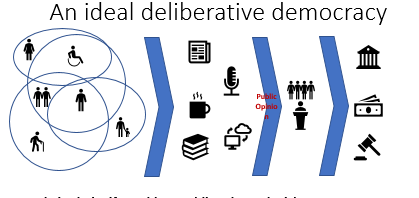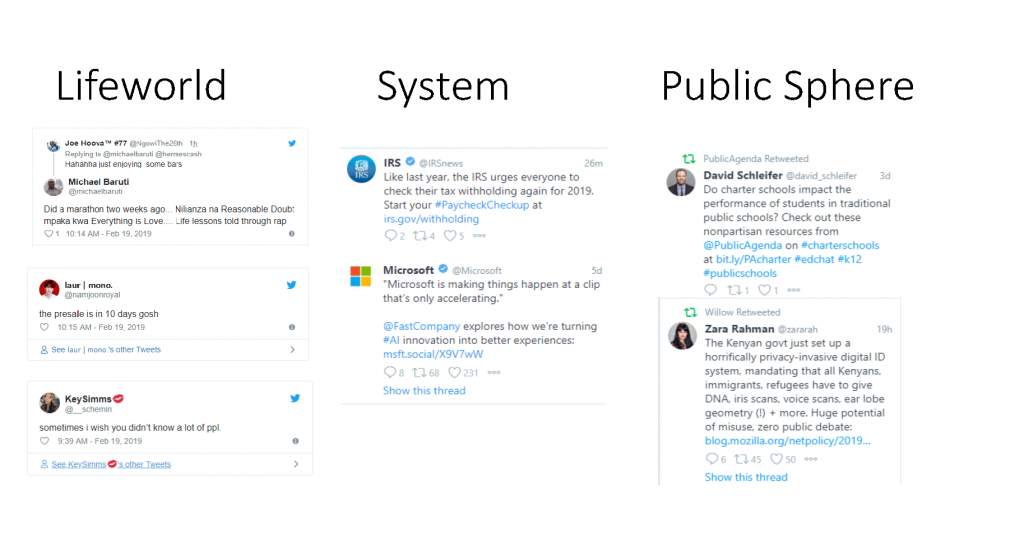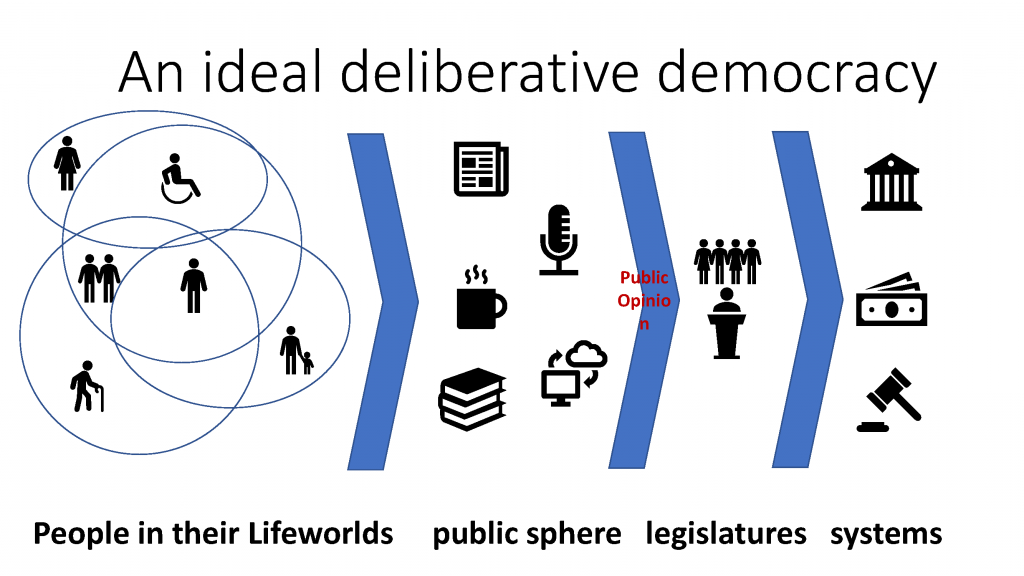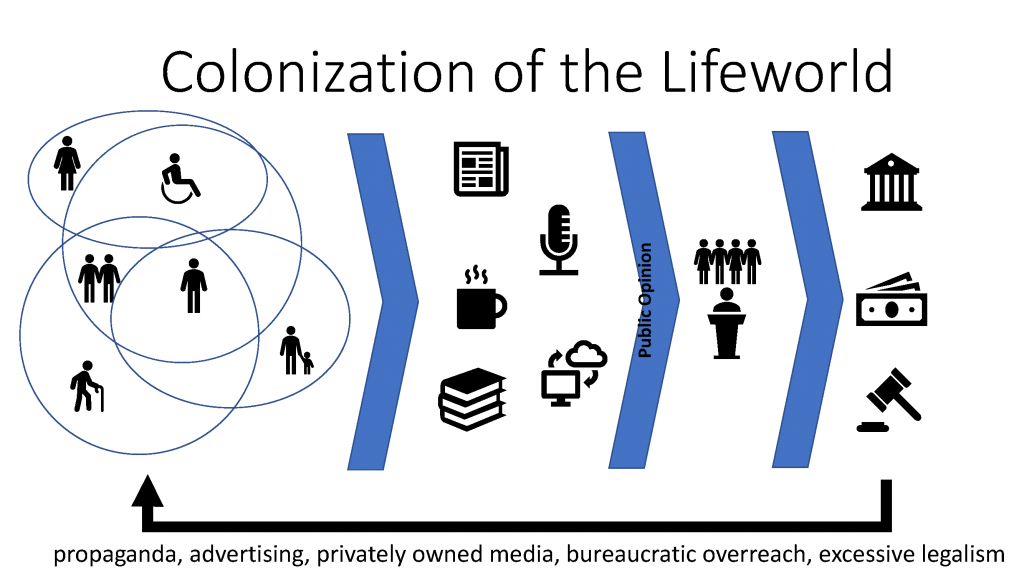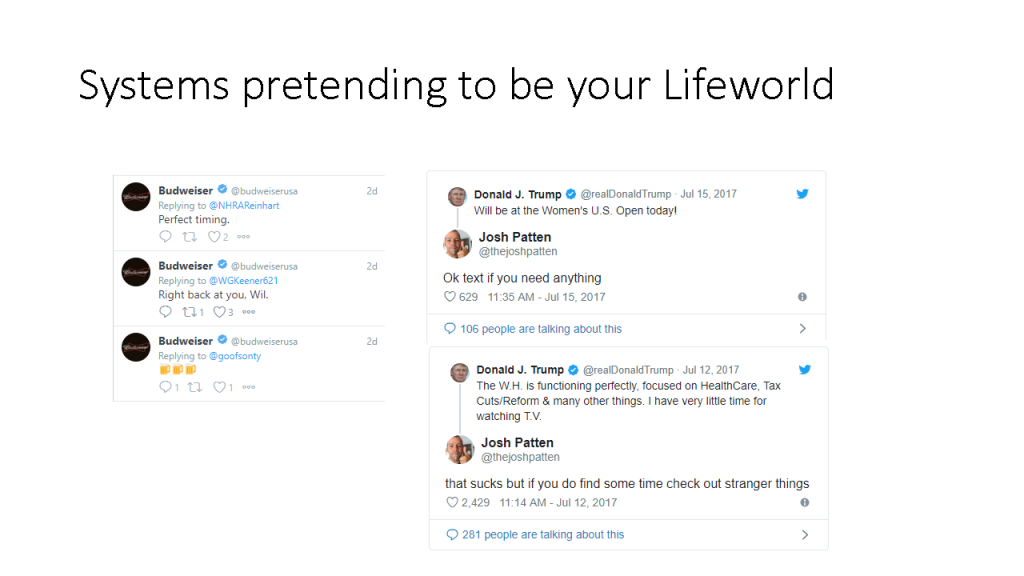- Facebook132
- Twitter87
- Total 219
At Tisch College, we have a Civic Science initiative, which has roots in an NSF-funded effort under the same name. Here is my own personal working definition of “Civic Science.”
The word “science” in this phrase is relatively clear, although there may be significant questions about whether Civic Science should extend to the social sciences (in which there are other movements for greater civic relevance) and whether Civic Science has different implications for science and mathematics as compared to technology and engineering—the four components of “STEM.”
The word “Civic” is more contested, having assumed many meanings since the Roman Republic. We find the following definition useful. To be civic means to ask the question: “What should we do?” (Shaffer 2013). (Apologies for some self-plagiarization in the next three paragraphs.)
This question ends with “do” because a civic life requires acting: changing or preserving things in the world, not just forming opinions about them. The word “should” in the question signifies that the civic perspective is an ethical one. Civic agents must identify right or good goals and decide which means are proper.
The subject of the question is “we”: a real, identifiable group to which one can belong. The subject is not “I,” because any individual lacks sufficient capacity to change the world and has too narrow a perspective to be wise. Although individual ethics is important, a civic perspective requires working in groups. Importantly, the subject is “we” rather than some entity outside the group. The civic question is not “What should be done?” or “What should the government do?” but “What should we do?” Sometimes other people bear the primary responsibility for addressing an injustice, but we must still clarify that obligation to them. Communicating a critique or a demand is an action that groups take. Because the question is about “we,” it reflects a fundamental “feeling of responsibility for the world” (Havel 1992) that is definitive of civic life.
People who ask the civic question face myriad concrete challenges (climate change, racial injustice, and many more). They will also confront three general questions just as a result of trying to take civic action:
- How to form groups that actually work? Specifically, what structures, incentives, and rules allow groups to accomplish their goals, sustain their activities, and coordinate the efforts of their individual members? Functioning groups include associations, organizations, institutions, firms, and networks, any of which can be designed well or badly.
- How to deliberate contested questions of value? Since the civic question is “What should we do?” civic actors necessarily confront matters of value. As human beings, our best method for addressing such matters is to discuss them with other people who hold different perspectives. (Here we use the term “discussion” very broadly, to include reading an ancient text or watching a film from a distant land to learn other perspectives). Discussions can promote learning, but they can also fail because of propaganda, ideology, group-think, motivated reasoning, and many other dysfunctions. So the question is: How to make discussions go relatively well?
- How to gain access for excluded groups? Even a well-functioning group with a good internal discussion may erect unjustifiable barriers to outsiders. A clear example would be a system of de jure racial segregation or apartheid, but there are many subtler cases, in which some people have official rights to participate but are placed at systematic disadvantage. Civic action is then about gaining inclusion on fair terms and without triggering a cycle of violence. (A related goal may be peaceful separation, as, for example, in a movement for national independence.)
Science is deeply involved with each of these three questions.
First, science is a set of functioning institutions. It consists of laboratories, training programs, credentials, titles, journals, societies, government agencies, grants, contracts, data, and intellectual property, among other components. Science employs distinctive organizational techniques, such as blind peer review and an obligation to cite previous work. These techniques may reflect high ideals, such as Robert Merton’s CUDOS norms (1942):
- Communism: a scientific discovery is given away to all, as quickly as possible, along with all the necessary background information, procedures, data, etc.
- Universalism: the quality of the work, not the nationality or race or gender of the researcher, counts
- Disinterestedness: no pay for particular results; academic freedom. Blind reviewing keeps those under review from currying favor with the powerful
- Organized Skepticism: every theory is taken to be falsifiable.
At the same time, science may be deeply influenced by indefensible norms, such as deference to authority within a lab or the motives of funders.
Science is not a democracy: there are no popular votes on what constitutes scientific knowledge. And science is not a market: basic knowledge is not for sale. However, both democratic governments and markets are thoroughly implicated with science. The question for Civic Science is whether the organizational forms that science takes today are satisfactory for a public that seeks to ask, “What should we do?”
Second, contested questions of value—which constantly arise for civic actors—often have scientific dimensions. There are no purely empirical answers to such questions as, “At one point do developing human beings gain intrinsic value?” or “How much pollution should we allow to enable economic growth?” Yet these questions do have complex empirical aspects that can be challenging for non-specialists to understand. The logical positivists of the early 1900s made a sharp fact/value distinction and held that science could—and should—be value-free. Values were opinions; scientists produced facts. Although many professionals in STEM disciplines still hold that view implicitly, it is not philosophically defensible. So the civic questions are: How can scientists be part of good conversations about contested values that involve science? And how can the broader public have good conversations about science?
Third, questions of exclusion constantly arise in science. For example, LGBTQ Americans were largely excluded from decision-making about research on AIDS when the epidemic began. Their highly effective organizing changed science—its priorities, its demographics, and even the details of how clinical trials were designed and interpreted. It is not an exaggeration to say that “a strong and internally differentiated activist movement along with various organs of alternative media, including activist publications and the gay press” actually created scientific knowledge about HIV/AIDS by interacting with “immunologists, virologists, molecular biologists, epidemiologists, physicians, and federal health authorities” (Epstein, 1995). ACTUP was a classic example of a contentious or adversarial social movement that made demands on target authorities (Tilly 2004), but in this case, one of its outcomes was new scientific knowledge and medical treatments. This is an example of how the third generic problem faced by civic groups (how to gain access) can play out in science.
Civic Science works at the intersection of these three circles, and especially where “the civic” overlaps with science.
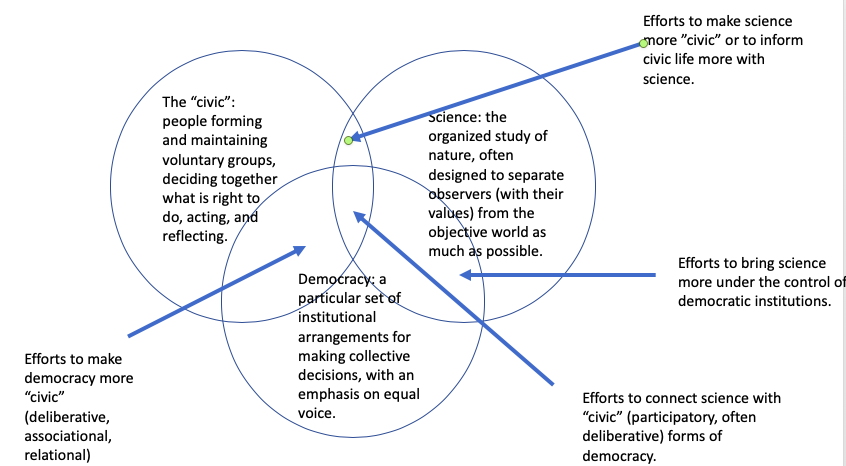
Civic Science in Relation to Other Movements
Given the definition developed in the previous section, it is clear that Civic Science does not stand alone but relates importantly to other fields and movements, both intellectual and practical.
Science, Technology and Society (STS): This is the interdisciplinary research field devoted to understanding science as a set of institutions in society and its relationship to other institutions, such as states and markets. It is ideologically pluralist and encompasses valuable disagreements, but the goal is not knowledge for its own sake. STS promotes understanding of science so that scientists and others can improve science. Feeding into STS are specific sub-disciplines such as the sociology of science and the philosophy of science.
Citizen Science: At its core, Citizen Science means enlisting laypeople to collect scientific data, such as environmental samples or observations of wildlife. Its goals can be to harvest more and better data or to give amateurs interesting tasks, but there is also sometimes an implicit reform agenda: to reduce status hierarchies that might otherwise keep laypeople out of science.
Community-Based Participatory Research: Particularly strong in the health sciences is the development of partnerships between credentialed scientists and community-based groups (usually nonprofits) that jointly shape research questions and methods and collect and interpret data together (Minkler 2002). Sometimes the goal is to generate better knowledge or to make sure that activists will be ready to use scientific findings, but (as with Citizen Science), there may also be an agenda of reducing status differentials between scientists and laypeople.
Civic renewal: Many organizations have arisen and come together in coalitions to advance “civic renewal” in the United States. This tends to mean efforts to strengthen deliberation, collaboration, and relationship-building in civil society (Levine, 2013). One signal moment was the National Commission on Civic Renewal in the late 1990s, but today such groups convene in the Bridge Alliance and other settings. Sirianni and Friedand (2005) map a Civic Renewal Movement.
Civic Studies: Launched with a manifesto by three past or future presidents of the American Political Science Association, a future Nobel Laureate in economics, and others (Boyte et al 2017), Civic Studies is a nascent field and intellectual movement that aims to study civic life with a combination of empirical, normative, and strategic methods (Levine 2014).
Dialogue and Deliberation: Such major political theorists as Jürgen Habermas (1987) and John Rawls (1997) have defended a role for public deliberation, meaning a relatively fair and reasonable discussion (the precise criteria vary) that influences government and public policy. Meanwhile, a large number of practical nonprofits actually organize dialogues or deliberations in various formats (Gastil & Levine 2005). There is a burgeoning literature on the impact of these efforts, creating a rich scholar/practitioner community.
Social movements that target science: In the tradition of ACTUP, citizens may come together to demand changes in the priorities, methods, and dominant paradigms of science. [Current examples? Gun violence? Climate?]
See also: Tisch College Postdoc in Civic Science; exemplary civic science: the CAFEH project; Civic Science; and science, democracy, and civic life
Citations
- Boyte, H., Elkin, S., Levine, P., Mansbridge, J., Ostrom, E., Soltan, K., & Smith, R. (2007). Summer institute of civic studies—Framing statement. Tufts University Summer Institute of Civic Studies, 28.
- Epstein, Stephen. 1995. the construction of lay expertise: AIDS activism and the forging of credibility in the reform of clinical trials. Science, Technology, & Human Values, 10/4 408-437
- Gastil, John & and Peter Levine. 2005 (The Deliberative democracy handbook: strategies for effective civic engagement in the twenty-first century. San Francisco: Jossey-Bass
- Habermas, Jürgen. 1987. The Theory of Communicative Action, translated by Thomas McCarthy Boston: Beacon Press.
- Havel, Vaclav. 1992 Address at Wroclaw University, Wroclaw, Poland, December 21, http://old.hrad.cz/president/Havel/speeches/1992/2112_uk.html
- Levine, Peter. 2015. We are the ones we have been waiting for: the promise of civic renewal in America. Oxford University Press
- Levine, Peter 2014. The Case for civic studies. In Peter Levine and Karol Soltan, Civic studies (Washington, DC: AAC&U/Bringing Theory to Practice
- Minkler, Meredith & Nina Wallerstein. 2002. “Introduction to community based participatory research.” In Minkler & Wallerstein (eds.) Community based participatory research for health. San Francisco: Jossey-Bass, 3-26
- Rawls, John. 1997. The idea of public reason revisited. University of Chicago Law Review. 64/3, 765-83.
- Shaffer, Timothy J. 2013. What should you and I do? Lessons for civic studies from deliberative politics in the New Deal. The Good Society, 22(2), 137-150.
- Sirianni, Carmen & Lewis A. Friedland. 2005. The civic renewal movement: community-building and democracy in the United States. Dayton, Ohio: Kettering Foundation Press, 2005
- Tilly, Charles. 2004. Social movements: 1768-2004. Boulder/London: Paradigm




